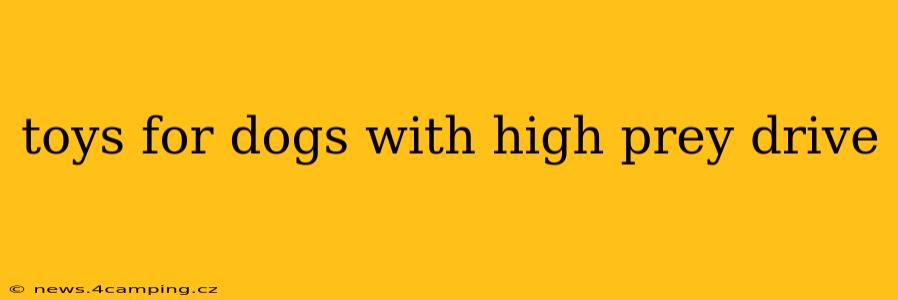Dogs with high prey drives possess a natural instinct to chase, stalk, and capture moving objects. This intense drive, while a part of their inherent nature, requires careful management to prevent destructive behaviors and ensure their well-being. Providing the right toys can significantly channel this energy into healthy outlets, preventing boredom and frustration. This guide explores the best toys for dogs with high prey drive, helping you choose the perfect playthings for your furry friend.
What Makes a Toy Good for a High-Prey Drive Dog?
The ideal toy for a high-prey dog isn't just any old chew; it needs to stimulate their natural instincts in a safe and engaging way. Key characteristics include:
- Movement: Toys that move unpredictably, mimicking the erratic movements of prey, are extremely effective. Think toys that wiggle, bounce, or flutter.
- Interactive Play: Toys that encourage interaction between you and your dog, such as fetch games, strengthen your bond and provide mental stimulation.
- Durability: A high-prey drive often means vigorous chewing and playing, so the toy needs to withstand considerable wear and tear. Look for tough, durable materials.
- Hiding and Searching: Toys that allow for hiding and retrieving, like puzzle toys or treat-dispensing balls, tap into their hunting instincts in a mentally stimulating way.
What Types of Toys Are Best for High-Prey Drive Dogs?
Here are several toy categories perfect for channeling your dog's high prey drive:
1. Interactive Puzzle Toys:
These toys require your dog to work for their reward, keeping them mentally engaged and satisfying their problem-solving instincts. Look for puzzle toys that dispense treats or kibble, making the process of retrieving the reward a game in itself. This taps into their natural hunting and foraging instincts.
2. Durable Chew Toys:
While not directly mimicking prey, tough chew toys satisfy the urge to gnaw and mouth, channeling their energy in a safe manner. Choose toys made from durable materials like Kongs (which can be filled with treats to add an extra layer of challenge), Nylabones, or tough rubber toys.
3. Fetch Toys:
Fetch is a classic game that perfectly satisfies a high-prey drive. Choose toys that are easy to throw and retrieve, made from durable materials that can withstand enthusiastic chomping. Consider balls, frisbees, or plush toys specifically designed for fetching.
4. Flirt Poles:
These toys consist of a long pole with a toy attached at the end, allowing for a stimulating game of chase and retrieve. The unpredictable movement of the toy mimics prey, offering a rewarding and exciting experience.
5. Tugs-of-War Toys:
These toys engage your dog physically and mentally, allowing for a satisfying tug-of-war game. Opt for durable ropes or fabrics that can withstand strong pulling. This allows for a controlled outlet for their prey drive, building trust and communication between you and your dog.
H2: What about soft toys? Are they suitable?
Soft toys can be enjoyable for some dogs, but for those with a strong prey drive, they may be destroyed quickly. If you do offer soft toys, supervise play closely and choose those made of extremely durable, reinforced materials. Consider rotating toys to prevent your dog from becoming overly focused on one item.
H2: How often should I play with my high-prey drive dog?
Regular playtime is crucial for dogs with high prey drives. Aim for at least two dedicated play sessions per day, incorporating a mix of different toys and activities. This helps prevent boredom and frustration, reducing the likelihood of destructive behaviors.
H2: My dog destroys every toy! What should I do?
If your dog consistently destroys toys, consider the following:
- Evaluate the toy's durability: Choose toys specifically designed for aggressive chewers.
- Rotate toys: Offering a variety of toys keeps your dog engaged and prevents fixation on a single item.
- Supervise playtime: Close supervision minimizes the chance of destructive behavior and ensures safe play.
- Consider puzzle toys: These challenge your dog mentally, offering a different kind of engagement than just chewing.
- Consult a professional: A veterinary behaviorist or certified dog trainer can provide guidance and create a personalized plan to address your dog's destructive chewing habits.
Remember, providing appropriate toys and engaging in regular play is essential for the well-being of dogs with high prey drives. By understanding their needs and choosing the right toys, you can help them channel their natural instincts in a safe, healthy, and fun way. This approach fosters a strong bond between you and your canine companion, leading to a happier and more fulfilling life for both of you.
